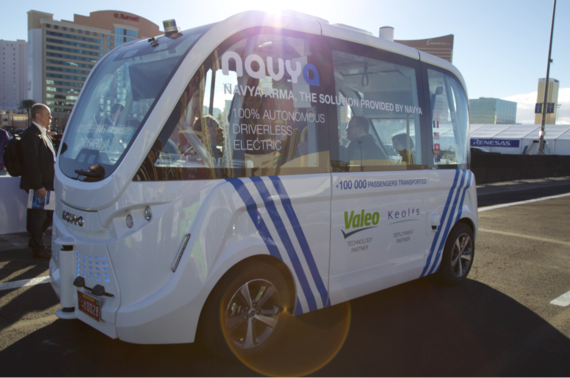One of the most exciting commitments coming from the auto and technology makers during CES 2017 is the ambition to realize driverless car capability for city streets as early as 2020. Such cars will have level 4 autonomy whereby they can drive themselves on city streets and request driver intervention when unexpected road conditions occur that could pose a risk for accidents. To achieve level 4 autonomy, cars will require artificial intelligence (AI), high-definition (HD) maps, and vehicle-to-vehicle communications:
- Artificial intelligence allow cars to make complex decisions when navigating urban traffic conditions.
- HD maps allow highly automated vehicles to pinpoint themselves on the road as a basis for real-time traffic data.
- Vehicle-to-vehicle communications allow nearby cars to broadcast speed, steering wheel position and brake status so that a car can predict traffic conditions ahead and avoid issues.
Some of the most notable of the auto and technology makers behind this 2020 goal include Nissan and the partnership between Audi and Nvidia. Nissan has been working with NASA on a project called SAM - Seamless Autonomous Mobility. The idea behind SAM is that all cars and buses will have no drivers. If a vehicle is unable to make a decision due to unexpected traffic conditions or an obstruction on the road, a human monitoring the vehicle can remotely take appropriate action.
Meanwhile, Nvidia announced at CES their new Xavier AI Car Supercomputer. It's fast enough for AI processing and machine learning. Audi will work with Nvidia to use these computers to be the brains of their vehicles.
Last year at CES, auto and technology makers were only talking about driverless cars and showing theoretical videos. This year, the technology has made significant progress; it went from driverless cars in theory to driverless cars in demonstration. Valeo, global manufacturer and supplier of automotive technology to most major automakers took me for a ride in their driverless Valeo eCruise4U. It's a Volkswagen Golf outfitted with all their latest driverless radar and camera technology.
If you remember, the early Google driverless car was outfitted with all kinds of large sensor technology mounted on the car. Not so with Valeo's Golf which has radar and camera technology seamlessly incorporated as part of the vehicle.

Here is a video I made of my in-car experience. Without the use of hands or feet, the car effectively drove in stop and go traffic. In addition, the car responded with smooth braking when two other cars sharply cut in front. Amazing! Clearly, technology is progressing to navigate complex urban traffic -- the most useful scenario for putting a car into autopilot.
I also went for a ride in this autonomous shuttle, which did not have a steering wheel or driver's cockpit. You simply selected your destination on a touch screen and the shuttle took you to where you wanted to go. They even demonstrated collision avoidance with a pedestrian (a professional exhibitor).

Let us know what you think about the prospect of driverless cars by 2020 by commenting below. Do you think it is ambitious? A recent survey conducted by Kanetix.ca showed 26 per cent of Canadians could not wait for the driverless car to arrive while 56 per cent will be observing how the technology progresses before they embrace the idea.
Follow HuffPost Canada Blogs on Facebook